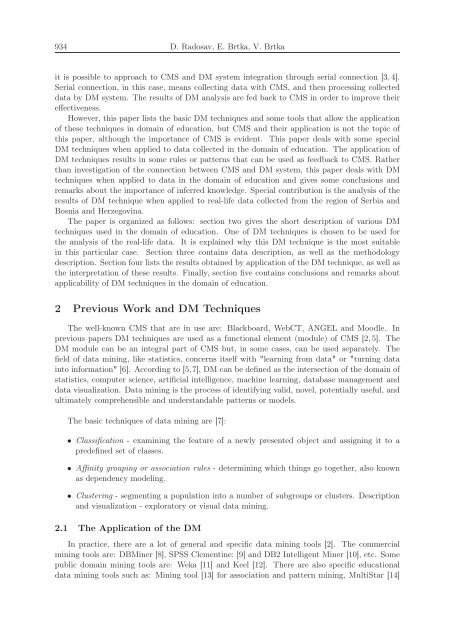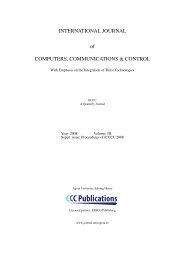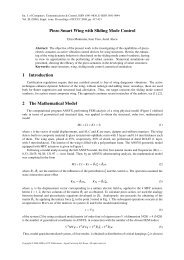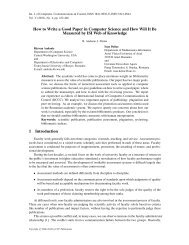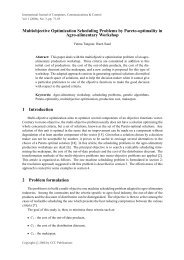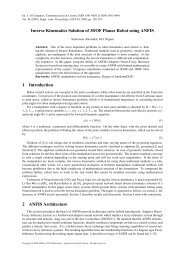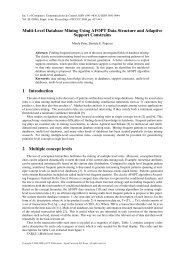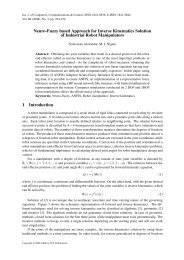Mining Association Rules from Empirical Data in the Domain of ...
Mining Association Rules from Empirical Data in the Domain of ...
Mining Association Rules from Empirical Data in the Domain of ...
You also want an ePaper? Increase the reach of your titles
YUMPU automatically turns print PDFs into web optimized ePapers that Google loves.
934 D. Radosav, E. Brtka, V. Brtka<br />
it is possible to approach to CMS and DM system <strong>in</strong>tegration through serial connection [3,4].<br />
Serial connection, <strong>in</strong> this case, means collect<strong>in</strong>g data with CMS, and <strong>the</strong>n process<strong>in</strong>g collected<br />
data by DM system. The results <strong>of</strong> DM analysis are fed back to CMS <strong>in</strong> order to improve <strong>the</strong>ir<br />
effectiveness.<br />
However, this paper lists <strong>the</strong> basic DM techniques and some tools that allow <strong>the</strong> application<br />
<strong>of</strong> <strong>the</strong>se techniques <strong>in</strong> doma<strong>in</strong> <strong>of</strong> education, but CMS and <strong>the</strong>ir application is not <strong>the</strong> topic <strong>of</strong><br />
this paper, although <strong>the</strong> importance <strong>of</strong> CMS is evident. This paper deals with some special<br />
DM techniques when applied to data collected <strong>in</strong> <strong>the</strong> doma<strong>in</strong> <strong>of</strong> education. The application <strong>of</strong><br />
DM techniques results <strong>in</strong> some rules or patterns that can be used as feedback to CMS. Ra<strong>the</strong>r<br />
than <strong>in</strong>vestigation <strong>of</strong> <strong>the</strong> connection between CMS and DM system, this paper deals with DM<br />
techniques when applied to data <strong>in</strong> <strong>the</strong> doma<strong>in</strong> <strong>of</strong> education and gives some conclusions and<br />
remarks about <strong>the</strong> importance <strong>of</strong> <strong>in</strong>ferred knowledge. Special contribution is <strong>the</strong> analysis <strong>of</strong> <strong>the</strong><br />
results <strong>of</strong> DM technique when applied to real-life data collected <strong>from</strong> <strong>the</strong> region <strong>of</strong> Serbia and<br />
Bosnia and Herzegov<strong>in</strong>a.<br />
The paper is organized as follows: section two gives <strong>the</strong> short description <strong>of</strong> various DM<br />
techniques used <strong>in</strong> <strong>the</strong> doma<strong>in</strong> <strong>of</strong> education. One <strong>of</strong> DM techniques is chosen to be used for<br />
<strong>the</strong> analysis <strong>of</strong> <strong>the</strong> real-life data. It is expla<strong>in</strong>ed why this DM technique is <strong>the</strong> most suitable<br />
<strong>in</strong> this particular case. Section three conta<strong>in</strong>s data description, as well as <strong>the</strong> methodology<br />
description. Section four lists <strong>the</strong> results obta<strong>in</strong>ed by application <strong>of</strong> <strong>the</strong> DM technique, as well as<br />
<strong>the</strong> <strong>in</strong>terpretation <strong>of</strong> <strong>the</strong>se results. F<strong>in</strong>ally, section five conta<strong>in</strong>s conclusions and remarks about<br />
applicability <strong>of</strong> DM techniques <strong>in</strong> <strong>the</strong> doma<strong>in</strong> <strong>of</strong> education.<br />
2 Previous Work and DM Techniques<br />
The well-known CMS that are <strong>in</strong> use are: Blackboard, WebCT, ANGEL and Moodle. In<br />
previous papers DM techniques are used as a functional element (module) <strong>of</strong> CMS [2,5]. The<br />
DM module can be an <strong>in</strong>tegral part <strong>of</strong> CMS but, <strong>in</strong> some cases, can be used separately. The<br />
field <strong>of</strong> data m<strong>in</strong><strong>in</strong>g, like statistics, concerns itself with "learn<strong>in</strong>g <strong>from</strong> data" or "turn<strong>in</strong>g data<br />
<strong>in</strong>to <strong>in</strong>formation" [6]. Accord<strong>in</strong>g to [5,7], DM can be def<strong>in</strong>ed as <strong>the</strong> <strong>in</strong>tersection <strong>of</strong> <strong>the</strong> doma<strong>in</strong> <strong>of</strong><br />
statistics, computer science, artificial <strong>in</strong>telligence, mach<strong>in</strong>e learn<strong>in</strong>g, database management and<br />
data visualization. <strong>Data</strong> m<strong>in</strong><strong>in</strong>g is <strong>the</strong> process <strong>of</strong> identify<strong>in</strong>g valid, novel, potentially useful, and<br />
ultimately comprehensible and understandable patterns or models.<br />
The basic techniques <strong>of</strong> data m<strong>in</strong><strong>in</strong>g are [7]:<br />
• Classification - exam<strong>in</strong><strong>in</strong>g <strong>the</strong> feature <strong>of</strong> a newly presented object and assign<strong>in</strong>g it to a<br />
predef<strong>in</strong>ed set <strong>of</strong> classes.<br />
• Aff<strong>in</strong>ity group<strong>in</strong>g or association rules - determ<strong>in</strong><strong>in</strong>g which th<strong>in</strong>gs go toge<strong>the</strong>r, also known<br />
as dependency model<strong>in</strong>g.<br />
• Cluster<strong>in</strong>g - segment<strong>in</strong>g a population <strong>in</strong>to a number <strong>of</strong> subgroups or clusters. Description<br />
and visualization - exploratory or visual data m<strong>in</strong><strong>in</strong>g.<br />
2.1 The Application <strong>of</strong> <strong>the</strong> DM<br />
In practice, <strong>the</strong>re are a lot <strong>of</strong> general and specific data m<strong>in</strong><strong>in</strong>g tools [2]. The commercial<br />
m<strong>in</strong><strong>in</strong>g tools are: DBM<strong>in</strong>er [8], SPSS Clement<strong>in</strong>e: [9] and DB2 Intelligent M<strong>in</strong>er [10], etc. Some<br />
public doma<strong>in</strong> m<strong>in</strong><strong>in</strong>g tools are: Weka [11] and Keel [12]. There are also specific educational<br />
data m<strong>in</strong><strong>in</strong>g tools such as: <strong>M<strong>in</strong><strong>in</strong>g</strong> tool [13] for association and pattern m<strong>in</strong><strong>in</strong>g, MultiStar [14]


